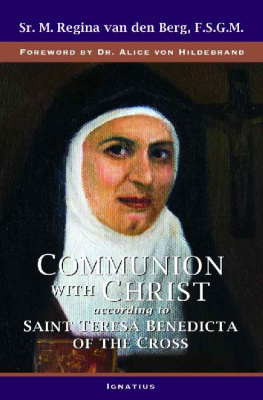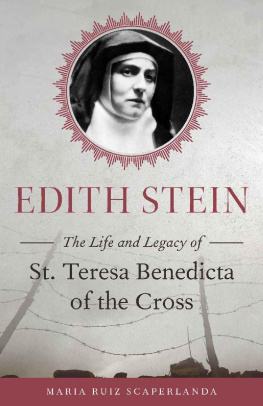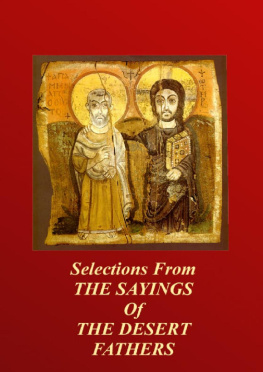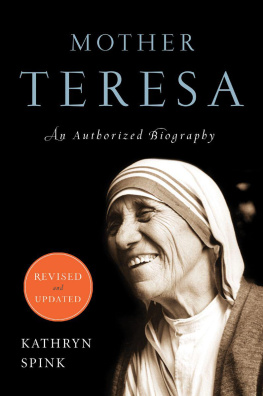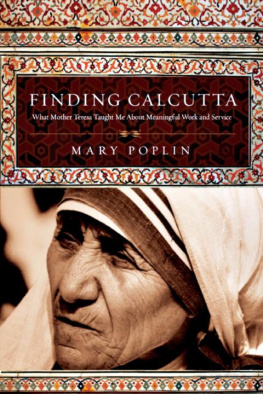Sister M. Regina van den Berg - Communion with Christ ; According to Saint Teresa Benedicta of the Cross
Here you can read online Sister M. Regina van den Berg - Communion with Christ ; According to Saint Teresa Benedicta of the Cross full text of the book (entire story) in english for free. Download pdf and epub, get meaning, cover and reviews about this ebook. year: 2015, publisher: Ignatius Press, genre: Religion. Description of the work, (preface) as well as reviews are available. Best literature library LitArk.com created for fans of good reading and offers a wide selection of genres:
Romance novel
Science fiction
Adventure
Detective
Science
History
Home and family
Prose
Art
Politics
Computer
Non-fiction
Religion
Business
Children
Humor
Choose a favorite category and find really read worthwhile books. Enjoy immersion in the world of imagination, feel the emotions of the characters or learn something new for yourself, make an fascinating discovery.
- Book:Communion with Christ ; According to Saint Teresa Benedicta of the Cross
- Author:
- Publisher:Ignatius Press
- Genre:
- Year:2015
- Rating:4 / 5
- Favourites:Add to favourites
- Your mark:
- 80
- 1
- 2
- 3
- 4
- 5
Communion with Christ ; According to Saint Teresa Benedicta of the Cross: summary, description and annotation
We offer to read an annotation, description, summary or preface (depends on what the author of the book "Communion with Christ ; According to Saint Teresa Benedicta of the Cross" wrote himself). If you haven't found the necessary information about the book — write in the comments, we will try to find it.
Communion with Christ ; According to Saint Teresa Benedicta of the Cross — read online for free the complete book (whole text) full work
Below is the text of the book, divided by pages. System saving the place of the last page read, allows you to conveniently read the book "Communion with Christ ; According to Saint Teresa Benedicta of the Cross" online for free, without having to search again every time where you left off. Put a bookmark, and you can go to the page where you finished reading at any time.
Font size:
Interval:
Bookmark:
COMMUNION WITH CHRIST
according to
Saint Teresa Benedicta
of the Cross
By Sister M. Regina van den Berg, F.S.G.M.
With a Foreword by Alice von Hildebrand
IGNATIUS PRESS SAN FRANCISCO
Scripture quotations are from the Revised Standard Version of the BibleSecond Catholic Edition (Ignatius Edition) copyright 2006 by the National Council of the Churches of Christ in the united States of America. All rights reserved.
Quotations from Essays on Woman by Edith Stein 1996 by the washington Province of Discalced Carmelites and from Philosophy of Psychology and the Humanities by Edith Stein 2002 by the Washington Province of Discalced Carmelites, as well as from other titles in The Collected Works of Edith Stein used with permission from ICS Publications, Washington, D.C., www.icspublications.org.
Cover art by Rellie Luciano Liwag
Cover design by Riz Boncan Marsella
2015 by Ignatius Press, San Francisco
All rights reserved
ISBN 978-1-58617-951-9 (PB)
ISBN 978-1-68149-106-6 (E)
Library of Congress Control number 2014943999
Printed in the United States of America
Edith Steinnow Saint Edith Steinwas born on October 12, 1891, on the Jewish Day of Atonement, Yom Kippur; entered the Church shortly after her thirtieth birthday; and was murdered in Auschwitz in 1942, a few months after her fiftieth birthday. Her life as a Catholic was short, and her life as a Carmelite nun still shorter: she entered the blessed ark in 1933. Nine years later, all that remained of her body, sanctified and nourished by the Eucharist since her conversion, was a handful of dust.
Now she is known the world over, and innumerable people benefit not only from her writings, but most of all from her holiness. From the moment she was baptized, her life was characterized by her ardent desire to be united to the One whom she now acknowledged to be the Savior of the world, the King of the Jews.
Many books have been written about her. Can a new book make significant new contributions? Without a moments hesitation I claim that it can, and for the following reason: every saint shares with us a loving message of such depth that no one work can exhaust the treasures hidden in striving for holiness. Moreover, each loving admirer of a saint will inevitably direct our attention to certain facets of that saints life and personality that have particularly enriched his own spiritual life. This is clearly the case for Sister M. Regina. Saint Ediths message is not, as people like to say, ahead of her time (a very equivocal statement) but is above her time. Truth is timeless. This is why Saint Augustines message is still very much alive today; the one of Heidegger and Sartre is fading fast.
Sister M. Regina is well qualified to write such a book. Having read much literature on the life and writings of this heroic victim of Nazism, she knows her topic; moreover, one feels that she not only loves her subject (can one understand a person for whom one has no sympathyshould I say empathy?) but clearly regards Saint Edith as a role model, and this is existentially felt throughout her book.
The book is made up of six chapters. Each one deserves a careful analysis. I will limit myself to consider some key ideas because they center on questions that are and always will be of burning interest: the metaphysical situation of man both as a creature, totally dependent upon his Creator, and as a mysterious person, composed not only of soul and body but also of two genders, which, while complementary, are of equal dignity.
Apart from the abysmal divide separating God from all His creatures, there is a chasm separating persons and nonpersons. To say that a monkey is closer to a rock or a plant than to the human person is likely to arouse the intellectual ire of many of our contemporaries who eloquently try to convince us that man is just a more highly developed chimpanzee: the difference separating them being one of degree, not of nature. Yet we stand on firm ground by adopting the position of Saint Bonaventure, who wrote in his Itinerarium mentis in Deum that all material creatures are only traces of God ( vestigia ). Man alone is made to Gods image ( imago ).
While studying at the University of Breslau, Edith was attracted to feminism; her strong sense of justice made her revolt against the denigration of the female sex as intellectually inferior. She was conscious that many of her male costudents were not on her level. She always achieved the highest grades. She did not hesitate to proclaim that she would not dream of giving up a challenging career for the sake of devoting herself to menial tasks in the narrow framework of the life of a married woman.
No one can go wrong in combating injustice, but one must have the right motivation. The problem with many types of feminism is that their mothers have totally lost sight of the beauty of femininity. Simone de Beauvoir wrote bluntly: women hate being women. They dislike their bodies. This famous mother of French feminism is, I fear, willfully blind to the glorious role assigned to woman in the Old Testament. Not only is hers the only body made from the body of a person, but, moreover, as revealed in the New Testament, there is only one person, a female, who was created without the stain of Original Sin. This woman, who is tota pulchra , was found worthy to become the Mother of the Savior, who has no earthly father. It is a woman, not a man, who is above angels: Regina Angelorum . Feminists are cursed by blindness.
The day Edith entered the Church, her eyes were opened, and she clearly knew she had the mission of reopening womens eyes to the beauty of the vocation of womanhood.
All revolutionary causes need a valid justification. Alas, too often this legitimate recrimination is poisoned by other factors, which instead of remedying an unjust situation create problems of equal, if not greater, magnitude. Edith, as a teenager, had abandoned her Jewish faith but not her ardent longing to find truth. This was the golden thread that led her to the one true Faith in the Catholic Church. Not only did her truth-thirsting soul immediately perceive and accept Christa Jewas the Savior of the world, but the message was meaningfully communicated to her through a woman, one of the greatest saints of our Holy Church, Saint Teresa of Avila. Clearly Gods providence was at work. Edith spent a whole night reading the autobiography of this great mystic. It was clear to her, upon closing the book, that the Catholic Church had the fullness of truth, and her decision to become a child of the Church was immediate and irrevocable. She heard the call and immediately responded: I am the handmaid of the Lord. She wanted to devote her life to the Bride of her Savior. Her vocation was born with her faith. This decision was not the fruit of a short-lived enthusiasm; it was a response to grace. What she had perceived was so luminous, so convincing, had so clearly the taste of the supernatural, that no further search was necessary. She bought herself a catechism, studied Catholic doctrine, and very soon was ready for baptism. With her brilliant intelligence and her loving heart opened to truth, she was ready for this great sacrament.
One thing is clear: the moment she had found the fullness of truth, she was going to live it and to strive to attain holiness; her ascension on the Holy Mount was her one and only desire. She never did things halfway: she became a daily communicant from the day of her baptism and devoted time to prayer and meditation. But she also realized she needed help and guidance. Saint Teresa taught her that spiritual guidance is crucial when striving for holiness. How easily we can imagine that our wishes are Gods will for us. Edith had an iron will. She came close to a nervous breakdown when, shortly after going to Gttingen, where the intellectual level was much higher than in Breslau, she had to acknowledge that, to her amazement, she could no longer achieve brilliant results by sheer will power. If this applied to her intellectual pursuits, it applied a fortiori to the science of the cross.
Next pageFont size:
Interval:
Bookmark:
Similar books «Communion with Christ ; According to Saint Teresa Benedicta of the Cross»
Look at similar books to Communion with Christ ; According to Saint Teresa Benedicta of the Cross. We have selected literature similar in name and meaning in the hope of providing readers with more options to find new, interesting, not yet read works.
Discussion, reviews of the book Communion with Christ ; According to Saint Teresa Benedicta of the Cross and just readers' own opinions. Leave your comments, write what you think about the work, its meaning or the main characters. Specify what exactly you liked and what you didn't like, and why you think so.

